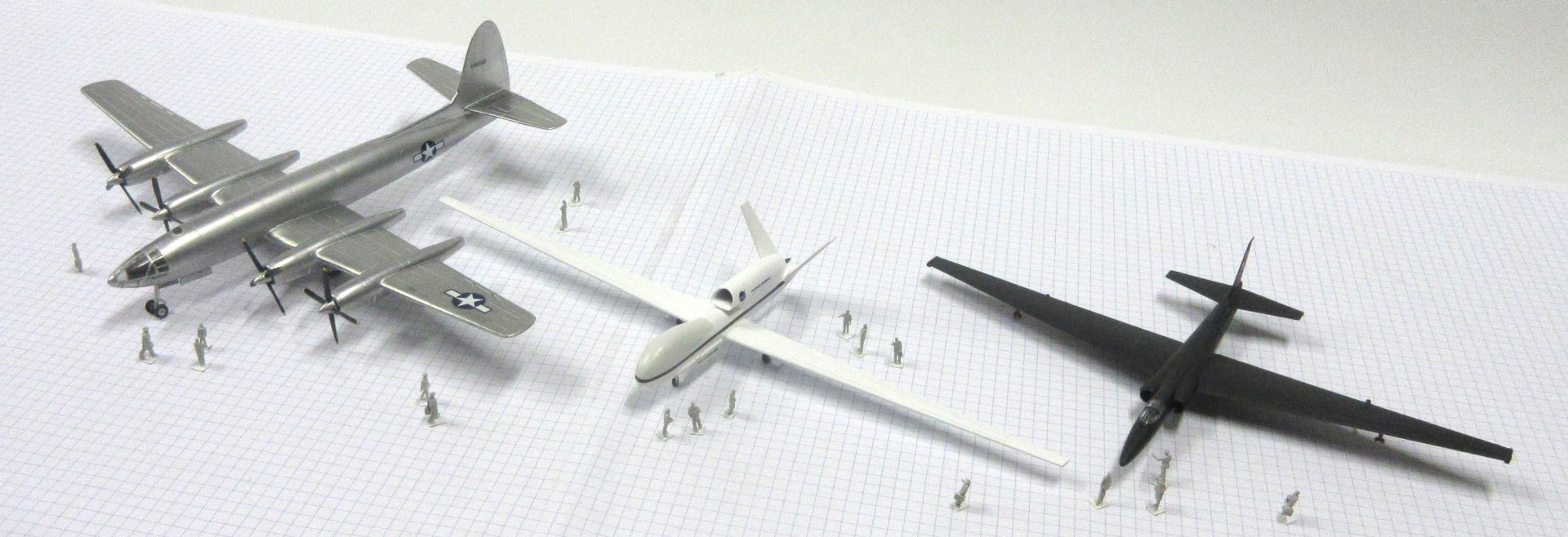Big Eyes in the Sky
Republic XF-12 – Lockheed U-2R – Northrop Grumman RQ-4
This week let’s look as three aircraft that go about their business quietly and at a great distance. Perhaps the first military role given to aircraft was to look down upon the surface to see what is happening so that the decision makers can better judge how to employ their resources. As warfare became more industrialized and more technically sophisticated commanders needed better and quicker intelligence, leading to better performing reconnaissance platforms that flew higher and further with the most modern sensors that technology could devise. These three aircraft represent three steps in that direction.

Republic XF-12 in 1/144 by Anigrand
This aircraft was designed to meet a USAAC requirement for a high speed, high altitude long range photo reconnaissance aircraft capable of flying over Japan during the Pacific War. The requirement was for an aircraft that could fly 4,000 miles at 400 miles an hour at 40,000 feet. Planning for the XF-12 began in 1943 and the first prototype made its first flight in 1946. It was highly streamlined and exceeded all its specified requirements. However, by then jet engines promised aircraft with even better performance and modified B-29s and B-50s were used while they were being developed, so only two XF-12s were built.
This model was made using the Anigrand 1/144 kit. It was not difficult to make but lacks some of the detail that might be found in a better injection moulded kit. Unfortunately this is the only available kit of this aircraft but, on the positive side, it was an extremely streamlined aircraft so a better kit would not have looked much different. As a side note, Anigrand also offer a kit of the XF-12 in 1/72 which I tried to make a few years ago. It is big and heavy but some of the major parts were so warped that I couldn’t finish it. You might have better luck
Lockheed U-2R in 1/144 by Dragon
This aircraft is an improved version of the U-2 high altitude reconnaissance aircraft developed in the 1950s to fly over Russia at a height that it could not be intercepted. Eventually one was shot down by a Russian missile but there remained other useful roles for the U-2. In the 1980s an improved version was made, the U-2R. It was about thirty percent larger than earlier versions and had a stronger airframe. It could carry up to 2,300kg of sensors and fly over 7,000km with a service ceiling of 24,000 meters. Fourteen were built and they have since been upgraded to U-2S standard with improved engines and systems.
I made this kit using the Dragon 1/144 kit which was first published in 2012. It is a neat little kit that goes together easily and presents few problems. Dragon also published the TR-1A version of the U-2 which has the large under-wing pods missing from the U-2R kit. There is a nice in box review of this kit on the Aeroscale website and the review on Cybermodeler concludes that ‘it will make a really nice project that doesn’t take lots of time or effort to complete’. Another advantage is that if you want a model of this aircraft making the 1/144 kit, rather than one in a larger scale, is going to save you a lot of shelf space.
Northrop Grumman RQ-4 in 1/144 by Miniwings
This aircraft is a high-attitude remotely piloted surveillance aircraft developed in the United States in the 1990s. The first RQ-4A flew in February 1998 and the first of the more advanced RQ-4B models flew for the first time in March 2007. They are flown from the ground by remote control and have an endurance of over 34 hours cruising at up to 60,000 feet. They have advanced electro-magnetic and optical sensors that can survey up to 100,000 square kilometers in a day. The Australian government has ordered three similar aircraft, MQ-4Cs, which the RAAF will use mainly for maritime surveillance of the waters around northern Australia.
This model was made using the Miniwings 1/144 kit, which is the only one there is in this scale. (I’ve also made the Italeri 1/72 model and it is HUGE, so many modellers with limited space might want to consider making this kit instead.) Miniwings offer three versions of this kit including this NASA model. I think the all-over white colour scheme emphasizes the aircraft’s unusual shape better than the camouflaged military versions. There are a few problems with making this model but there is a detailed build review on the internetmodeler website which walks you through the necessary work better than I could in only a few words. It is not hard work and the end result looks unexpectedly nice.



